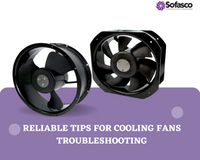Overheating is a silent killer for laptop performance. Whether you're gaming, editing videos, or running heavy software, keeping your device cool is essential. But when it comes to managing laptop temperature, which solution is more effective: the built-in laptop fan or an external cooling pad fan?
In this blog, we’ll break down the differences between the two, explore how each works, and help you decide which cooling method offers better protection for your device.
What Is a Laptop Fan?
The laptop fan is an internal cooling component that works alongside heat sinks and thermal paste to regulate CPU and GPU temperatures. It activates automatically based on your system's thermal needs.
Key Features:
- Built into the device
- Controlled by internal sensors
- Designed for the specific thermal profile of the laptop
What Is a Cooling Pad Fan?
A cooling pad fan is an external accessory placed under your laptop. It typically features one or more USB-powered fans that help increase airflow to the laptop’s underside, where most heat accumulates.
Key Features:
- External, plug-and-play device
- Multiple fan configurations
- Elevates the laptop for better air circulation and ergonomics
Key Differences Between Laptop Fans and Cooling Pad Fans
|
Feature |
Laptop Fan |
Cooling Pad Fan |
|
Location |
Inside the laptop |
Underneath the laptop (external) |
|
Power Source |
Internal battery or charger |
USB-powered |
|
Noise Level |
Moderate to high (under load) |
Low to moderate |
|
Customizability |
Not adjustable |
Some models offer speed and light control |
|
Maintenance |
Harder to clean or replace |
Easy to clean and replace |
Which One Does the Job Better?
Laptop Fan: Ideal for Direct Cooling
The laptop fan directly cools the CPU and GPU, reacting to thermal load. It’s the first line of defense against overheating and works best when your internal thermal system is well-maintained.
Cooling Pad Fan: Ideal for Supplemental Cooling
Cooling pads don’t replace internal fans; they assist them. They’re especially useful if:
- Your laptop has poor ventilation
- You use it on soft surfaces (like a bed or couch)
- You're doing high-performance tasks for long periods
Tips to Improve Laptop Cooling
- Elevate your laptop slightly using a stand or cooling pad
- Avoid blocking vents (never use on blankets or pillows)
- Use software to monitor and manage fan speeds
- Clean internal fans periodically (or get professional servicing)
- Apply fresh thermal paste every couple of years for optimal heat transfer
Laptop fans and cooling pads serve different but complementary roles.
Your laptop’s internal fan cools components directly, while a cooling pad adds external airflow, reducing surface and internal temperatures. If you want optimal performance and longevity, use both, especially during high-load tasks.
Frequently Asked Questions (FAQs)
Q1. Are cooling pads effective for laptops?
Yes, cooling pads improve airflow and help lower surface and internal temperatures during heavy use.
Q2. Do cooling fans work for laptops?
Yes, both internal fans and external cooling pads effectively prevent overheating and boost performance.
Q3. Do laptop cooling pads reduce fan noise?
Indirectly, yes. By keeping the laptop cooler, they reduce the need for internal fans to run at high speeds, which lowers noise.












